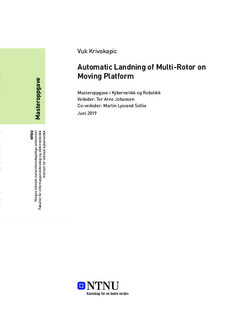Automatic Landning of Multi-Rotor on Moving Platform
Master thesis
Permanent lenke
http://hdl.handle.net/11250/2625685Utgivelsesdato
2019Metadata
Vis full innførselSamlinger
Sammendrag
Bruk av ubemannede luftfartøyer (UAV) i autonome offshore-oppdrag har økt drastisk de sisteårene. UAVene har gjort det mulig å utføre oppdrag i tøffe værforhold uten å risikere menneskeskader. Hoveddelene av et UAV oppdrag består av letting, cruise og landing. Alle tre delene er like viktige i utførelsen av ett autonomt oppdrag. Denne oppgaven presenterer utviklingav et system for autonom UAV landing basert på programvarene utviklet av Laboratório de Sistemas e Tecnologia Subaquática (LSTS).
All programvare og maskinvare som trengs for landingssystemet, og forbindelsen mellom dissepresenteres i avhandlingen. Matematiske ligninger av hexarotormodellen og miljøforstyrrelsersom påvirker landingsprosessen er avledet. Hastighetsstyringsalgoritmer er utviklet og bruktsom input til ArduPilot, programvaren for lavnivåkontroll. Flere feilhåndteringsalgoritmer erutviklet for å sikre at landingen utføres effektivt og trygt.
Simuleringsmiljøet er implementert i DUNE: Unified Navigation Environment. Simuleringerbrukes til å teste ytelsen til de utviklede algoritmene, og forberedelsene til forsøkene i feltet.Simuleringsresultatene er presentert og diskutert i avhandlingen.
To feltforsøk er utført. Forsøkene er utført med et 3DR Hexacopter, med DUNE som kjører påen BeagleBone black og ArduPilot som kjører på en PixHawk. Alle algoritmer som brukes isimuleringene, brukes også i feltet. Resultater fra feltforsøkene er presentert, diskutert og sammenlignet med simuleringsresultatene. Luftfartøyet var i stand til å gjennomføre landing i feltforsøkene. Noen avvik i de utviklede algoritmene er loppdaget, og et forslag til videreutviklinger utarbeidet. The use of unmanned aerial vehicles (UAV) in autonomous offshore missions has increaseddrastically in recent years. The UAVs have made it possible to carry out missions in roughweather conditions, without risking human injuries. The main parts of a UAV mission aretakeoff, cruise and landing. All three parts are equally important to carry out a successful autonomous mission. This thesis presents the development of a system for autonomous UAVlanding based on the software developed by Laboratório de Sistemas e Tecnologia Subaquática(LSTS).
All software and hardware needed for the landing system, and connection between those arepresented in the thesis. Mathematical equations of the hexarotor model and environmental disturbances affecting the landing process are derived. High-level velocity control algorithms aredeveloped and used as input to ArduPilot, the low-level control software. Several error handlingalgorithms are developed, in order to make sure that the landing is carried out efficiently andsafely.
The simulation environment is implemented in DUNE: Unified Navigation Environment. Simulations are used to test the performance of developed algorithms, and prepare for the field test.Results of the simulations are presented and discussed in the thesis.
Two field tests are performed. The tests are performed using a 3DR Hexacopter, with DUNErunning on a BeagleBone black and ArduPilot running on a PixHawk. All algorithms used forsimulations are used in the field as well. Results from the field test are presented, discussed andcompared with the simulation results. The vehicle was able to land in the field test environment.Some deviations in the developed algorithms are noticed and a proposal for further developmentis made.
